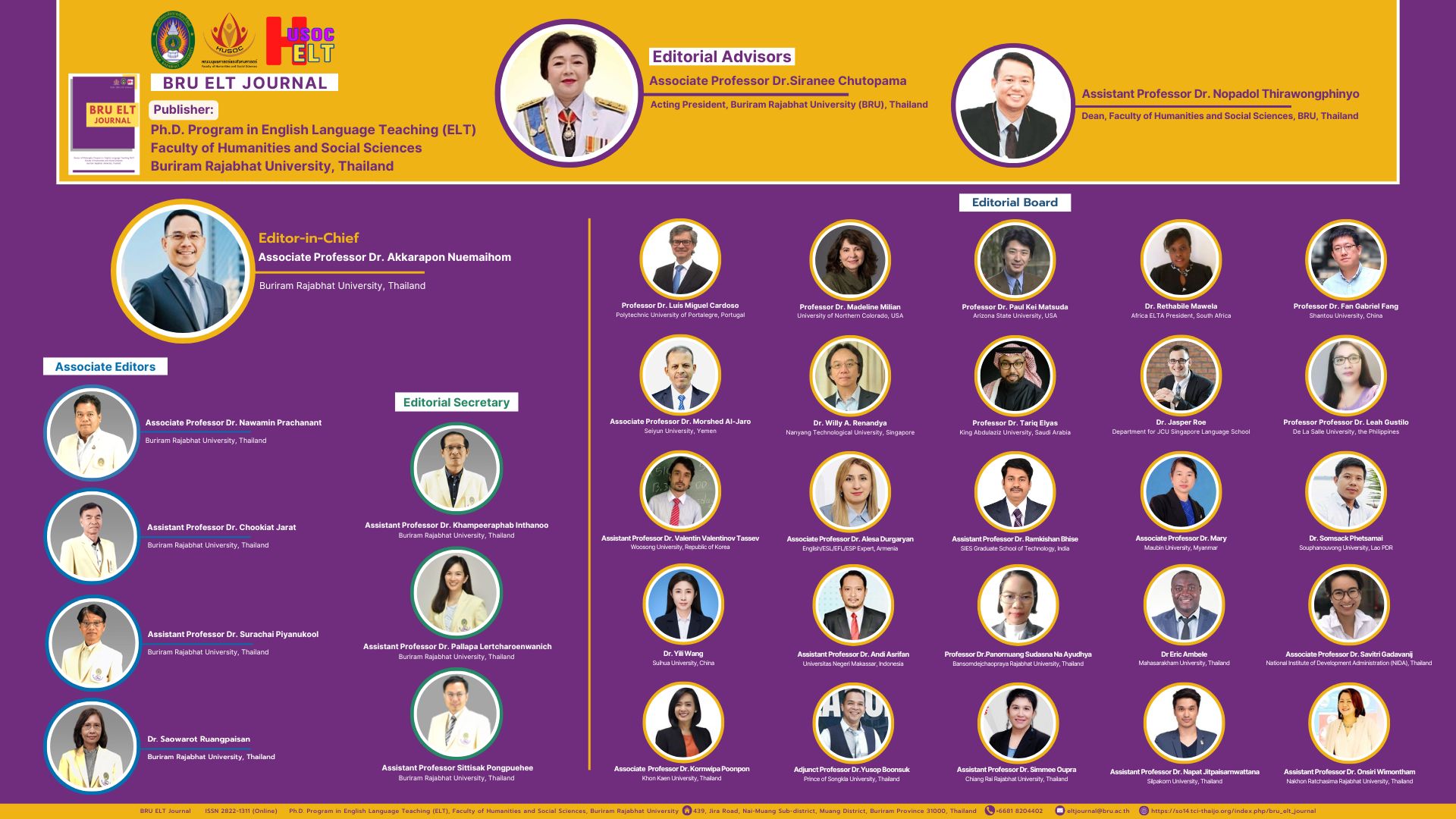Influence of Cultural and Linguistic Distance on Specific Terminology Equivalent Translation
DOI:
https://doi.org/10.14456/bej.2023.15Keywords:
cultural Influence, linguistic distance, food terminology, Thai, Lao, English, ChineseAbstract
The present study investigated the cultural and linguistic distance influences on specific terminology equivalent translation. Specific terminology in this research is food terminology. This is because food tradition is an important aspect of human and closed relates to human culture. The languages included in this study are Thai, Lao, and English, and Chinese Languages. The research procedure consists of conducting focus group in order to identify specific food terms of four ethnic community in a province in Thailand, named Ratchaburi Province, equivalent translation procedure, and questionnaire evaluation methods. The focus group method consisted of two groups of participants as ten representatives of ethnic community in the research area and the nine translators, who are native speakers of Lao, English, and Chinese Languages. Then, translation from Thai food terms to Lao, and English, and Chinese Languages by translators, who are native speakers of Lao, English, and Chinese Languages was conducted. Questionnaire evaluation was employed in two groups of subjects: nine translators and thirty bachelor’s degree students in translation course to study translation difficulties and 20 native speakers of each Lao, English, either Chinese language who read translation words obtained from translation procedure. The results revealed that translation and understanding difficulties from Thai to Lao was rated at being extremely easy, followed by from Thai to Chinese, and finally, from Thai to English was rated at being difficult. The causes of difficulties were explained in terms of specific cultural and linguistic distance influence. The paper also illustrates the examples of translation items to reveal the influence of cultural and linguistic distance on translation of specific terminology.
References
Al- Rushaidi, S.M. & Ali, H. I. (2017). Translating food menus from English into Arabic: Linguistic and cultural dilemmas. Arab World English Journal for Translation and Literary Studies, 1(1). http://dx.doi.org/10.24093/awejtls/vol1no1.14.
Baker, M. (1992). In other words: A coursebook on translation.routledge.
Baker, M. (1997). The routledge encyclopedia of translation studies, Part II: History and Traditions. Rutledge.
Cargnelutti, E., Tomasino, B., & Fabbro, F. (2021). Effects of linguistic distance on second language brain activations in bilinguals: An exploratory coordinate-based meta-analysis. Front. Hum. Neurosci., 15, https://doi.org/10.3389/fnhum.2021.744489.
Chiaro, D., & Rossato, L. (2015). Food and translation, translation and food. The translator,21(3), 237-243. http://dx.doi.org/10.1080/13556509.2015.1110934.
Chiswick, B. R., & Miller, P. W. (1998). English language fluency among immigrants in the United States. Research in Labor Economics, 17, 151-200.
Chiswick, B. R., & Miller, P. W. (2001, August). A model of destination language acquisition: Application to male immigrants in Canada. Demography, 38(3), 391-409.
Chiswick, B. R., & Miller, P. W. (2004). Linguistic distance: A quantitative measure Of the distance between English and other languages. IZA. Discussion Paper (1246), The Bonn, Germany: Institute for the Study of Labor.
Corder, S. P. (1981). Error analysis and interlanguage. Oxford University Press.
Crystal, D. (1987). The Cambridge encyclopedia of language. Cambridge University Press.
Draper, J., Garzoli, J., Kamnuansilpa, P., Lefferts, L., Mitchell, J., & Songkünnatham, P. (2019). The Thai Lao-Thailand’s largest unrecognized transboundary National ethnicity. Nations and Nationalism, 25(4), 1131-1152.
Ekasit, O., & Jiraporn, B. (2013). Some physical characteristics and bioactive compounds of young flattened rice (Khao-Mao). International Food Research Journal, 20(3), 1327-1332.
González–Vera, P. (2015). Food for thought: The translation of culinary references in animation. Íkala, Revista de Lenguaje y Cultura, 20(2), 247–264.
Grimes, J. E., & Grimes, B. F. (1993). Ethnologue: Languages of the world. Summer Institute of Linguistics.
Hart-Gonzalez, L., & Lindemann, S. (1993). Expected achievement in speaking proficiency. School of Language Studies, Foreign Services. Institute, Department of State.
Hutchinson, A. (2019). Instagram publishes new report on key food and drink content trends in the UK. https://www.socialmediatoday.com/news/instagram-publishes new-report-on-key-food-and-drink-content-trends-in-the/559963/
Hutchinson, W. K. (2002). Linguistic distance as a determinant of bilateral trade. Department of Economics, Vanderbilt University.
Jakobson, R. (2000). On linguistics aspects of translation. In Venuti, L (ed.). The Translation Studies Reader. Routledge, 113-118.
Kelly, L.G. (1979). The true interpreter. A history of translation theory and practice in the West. Basil Blackwell.
Kenny, D. (2009). Equivalence. In Baker, M. & Saldanha, G (eds.) Routledge encyclopedia of translation studies, eds. Routledge, 96–99.
Keyes, C. F. (1967). Isan: Regionalism in northeastern Thailand. Cornell University.
Leuven-Zwart, A. K. (1990). Translation and original, similarities and dissimilarities II. John Benjamins.
Li, F. K., & Solnit, D. B. (2007). Tai languages. Encyclopedia Britannica. https://www.britannica.com/topic/Tai-languages
McCloskey, D. (1998). The rhetoric of economics (2nd ed.). University of Wisconsin Press.
Mehrach, M. (1977). Towards a text-based model for translation evaluation. Ridden Print.
Munday, J. (2001). Introducing translation studies, theories and applications. Routledge.
Newmark, P. (1981). Approaches to translation. Pergamon Press.
Nida, E. A. (1964). Toward a science of translating. Brill.
Nida, E. A., & Taber, C. R. (1982). The theory and practice of translation. Brill.
Nord, C. (2005). Text analysis in translation: Theory, methodology, and didactic application of a model for translation-oriented text analysis. Rodopi.
Pillsbury, R. (1998). No foreign food: The American diet in time and place. Westview Press.
Pym, A. (2010). Exploring translation theories. Routledge.
Sapir, E. (1921). Language: An introduction to the study of speech. Harcourt, Brace and Co.
Sapir, E. (1949). Language. An introduction to the study of speech. Harcourt, Brace and Co.
Tourism Authority of Thailand. (2022). Ratchaburi. https://www.tourismthailand.org.
U.S. Bureau of the Census. 1(993). 1990 United States census of population and housing. Technical Documentation, Washington, DC.
U.S. Bureau of the Census. (2003). 2000 United States census of population and housing. Technical Documentation, Washington, DC.
Wardhaugh, R. (2002). An introduction to sociolinguistics (4th ed.). Blackwel Publishers.






